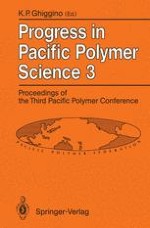Progress in Pacific Polymer Science 3 continues the record of the current status of major topics in polymer science.
The invited lecturers cover the following topics:
- Adding Value to Natural Polymers
- Polymers and the Environment
- Polymers in Mining and Mineral Processing
- Multicomponent Polymer Systems
- Characterization, Properties and Processing
- Functional Polymers
- Polymers for Medical Applications
- Polymer Recycling
- Polymer Surfaces of Biological Significance
- New and Advanced Polymer Materials
